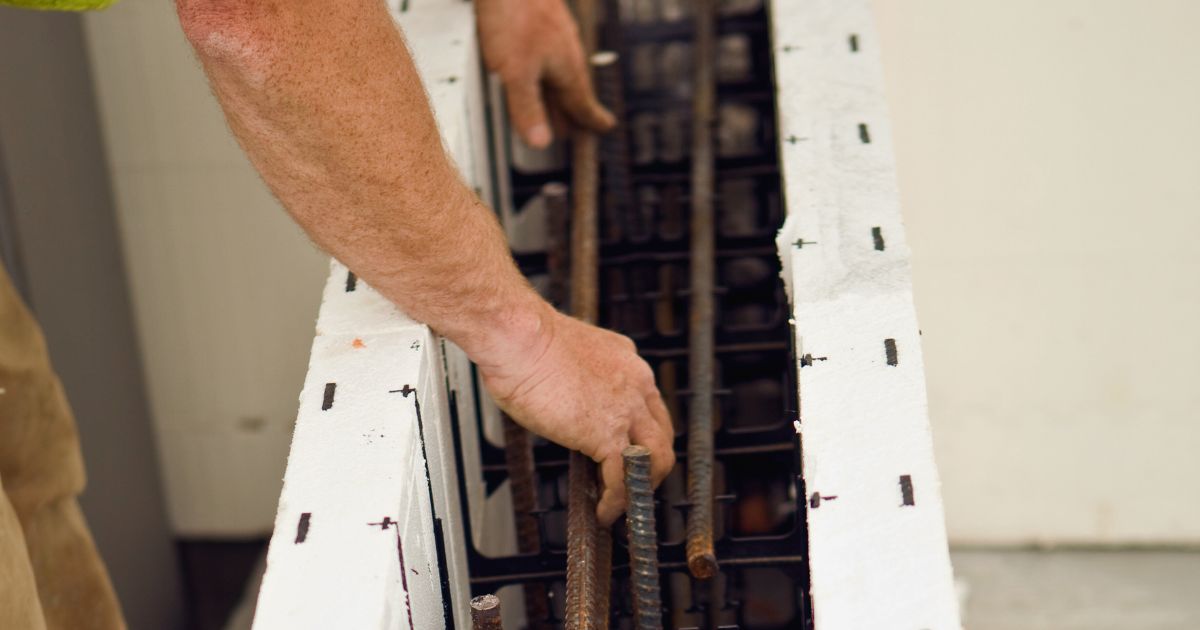Using insulated concrete forms (ICFs) for a retaining wall creates a more economical, flexible, durable, and attractive option compared to using concrete masonry units (CMUs) and structural insulated panels (SIPs). Like Fox Blocks, ICFs quickly create a freestanding concrete retaining wall ideal for patio walls, fences, and more.
What Are Retaining Walls?
Retaining walls correct slopes and embankments, hold back earth, and create usable flat space for patios, gardens, and other improvements. They support soil, rock, or other material behind them to change grade or elevate a yard. Other common uses include supporting roadways, controlling erosion along shorelines, creating tiered landscaping, and surrounding pools.
Various materials can build retaining walls, but they must withstand pressure and resist deterioration. The three most common choices are CMUs, SIPs, and ICFs.
Concrete Masonry Units
Concrete masonry units (CMUs) are a ubiquitous building material. They form by mixing Portland cement, aggregates like stone and sand, and water. The cement cures and bonds the aggregates into a solid, durable block.
CMUs come in various styles, including hollow, solid, and interlocking blocks. Builders stack CMUs like bricks to construct retaining walls, typically using mortar to bond courses. Other styles, like keystone blocks, use weight and interlocking shapes rather than mortar.
CMU retaining walls provide strength and longevity. But, laying CMU blocks is labor-intensive and time-consuming. CMU walls also require decorative facing like stucco or stone since the exposed blocks have an industrial look.
Structural Insulated Panels
Structural insulated panels (SIPs) emerged in the 1950s as a building material. SIPs sandwich rigid foam insulation between two structural skins, usually oriented strand board (OSB). The factory-cut panels stack to form straight, insulated exterior walls.
Though less common than CMU or ICF, builders can use SIPs for freestanding retaining walls. The main advantage is fast assembly compared to laying CMU.

However, the OSB facing is vulnerable to moisture damage compared to concrete. Also, SIPs adapt poorly to curved or angled walls.
Insulated Concrete Forms
Insulated concrete forms (ICFs) create concrete walls framed by foam forms. Manufacturers mold expanded polystyrene (EPS) into interlocking blocks and planks. Workers stack the lightweight forms and fill them with reinforced concrete to create solid poured walls.
The foam forms create a finished wall surface, unlike CMUs. ICF makes retaining wall construction far simpler than CMU and quicker than SIPs. The forms remain in place after pouring, eliminating the need for additional finishes. ICFs also allow more design flexibility than SIPs and greater durability than either alternative.
The Advantages of ICF Retaining Walls
Installing ICF blocks is straightforward and much faster than laying heavy CMUs. No mortaring or extensive training is required. Even inexperienced crews can stack ICF forms up to five times faster than block walls. ICFs also consolidate steps compared to CMU projects.
Because ICF installation is fast and easy, it needs smaller crews with less skill. The simple, repetitive process allows the use of inexpensive, unskilled labor. Training takes less than a day. ICFs consolidate steps compared to CMU projects.
You can easily cut EPS forms to create curves, angles, and steps. Concrete fills any shape evenly, unlike rigid SIPs limited to flat planes. This enables walls with peaks, valleys, steps, or smooth curves impossible with SIPs. You can build unique accent walls.
ICF forms durable EPS foam and reinforced concrete that will not rot, warp, or crack. The thermal mass resists freezing and thawing. Insulation provides moisture resistance. Integrated water barriers prevent flood damage. ICF retaining walls last decades longer than CMU or SIPs.
ICF forms stay in place to instantly create a finished facade. The EPS accepts various aesthetics like paint, stucco, stone, and brick. No added facing hides imperfect blocks. Decorative ICF treatments surpass rough CMU and damaged SIPs.
Why Choose ICF for Retaining Walls?
ICF retaining walls offer huge ease, speed, durability, and appearance advantages compared to CMU and SIP alternatives. You also gain flexibility for custom shapes and disaster and rot resistance. The integrated insulation provides added energy efficiency. ICF is the simplest, strongest, and most attractive retaining wall option for most projects.
So, Are ICF Retaining Walls the Best Choice?
For most residential and light commercial retaining walls, ICF provides the ideal balance of fast installation, superior strength, integral insulation, and design flexibility. The lighter forms reduce site preparation and equipment needs. Almost any shape integrates easily.
ICF retaining walls consolidate steps and need less skilled labor than CMU. They also avoid the moisture damage common with SIPs. No extra facing hides imperfections. Unless extreme loads require heavyweight concrete blocks, ICF forms the fastest and most durable retaining wall.
FAQs About ICF Retaining Walls
How Thick Should an ICF Retaining Wall Be?
Most residential ICF retaining walls are 8” to 12” thick. Thicker walls from 12” to 24” suit commercial projects or extra height. Professional engineering should determine the final thickness.
Can You Build Curved ICF Retaining Walls?
Yes, the flexible foam forms easily bend and shape to create smooth curves. Concrete fills forms of any shape. This allows you to create unique accent walls.
Do ICF Retaining Walls Need Reinforcement?
Yes. Steel rebar or helicon bars reinforce the concrete core against pressure loads. The manufacturer or engineer will recommend the ideal rebar grid.
Does ICF Have a Smooth Finish for Retaining Walls?
The ICF forms create a smooth wall that is ready for finishes. Paint, thin veneers, plaster coats, or exposed form joint patterns are common options. No added facing is required.











